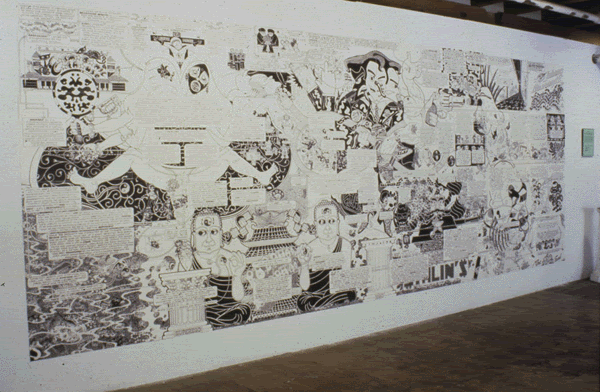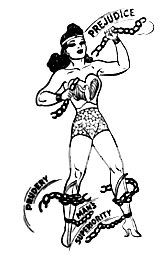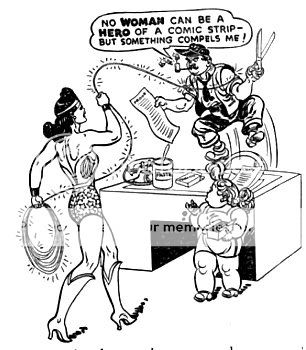I reviewed the book for TCJ when it came out. Ng Suat Tong says it’s more favorable in tone than my recent post. I know I didn’t bring up the business about Bechdel’s dad dropping out of grad school. But what strikes me is what a dreadful first sentence the piece has. I must have been paid by the preposition.
Fun Home is a set of seven essays about Bechdel’s memories of her father, a dominating but highly sissified man who led a secret life of chasing after boys while he raised his family and outfitted the family’s home as a sort of museum devoted to his particular aesthetic (cream settees, lilacs, “silk flowers, glass flowers, needlepoint flowers”). The book takes you inside a baffling childhood, one where not a whole lot could be counted on to hold steady, to match its official description. “My father began to seem mortally suspect to me long before I actually knew he had a dark secret,” Bechdel writes above a picture of her young self watching Dad apply his bronzing stick. Bechdel herself was gay and didn’t know it until college. Until then, she lived with a sense that she and her father were misfits for their proper roles — “inverts” was the the term she adopted later, “the homosexual as a person whose gender expression is at odds with his or her sex.” While at Oberlin, she did some thinking and came out. Her mother then told her about Mr. Bechdel’s secret life and soon began talking about a divorce. A few months later Mr Bechdel was dead. He jumped in front of a truck, but he jumped backwards, so whether his death was a suicide is hard to say. Fun Home admits the question is open but states its preference: Bechdel thinks her father killed himself because she managed to tell the truth.
The approach is high-toned and literary, so expect allusions, symbols, hidden meanings, hidden jokes, obtrusive elegance. Each chapter in Fun Home wind its way about one aspect or another of the family situation: obsessiveness (“The Canary-Colored Caravan of Death”), the unspoken drive to hold back unwelcome secrets (“The Ideal Husband”), Alison’s creeping sense that she and her father are not what they’re supposed to be (the well-named “In the Shadow of Young Girls in Flower”). The essays are so well constructed they snake you into their guts. The book is dense, but it’s a fast read and it locks the reader inside its atmosphere. The ink wash and the ever-present captions make the events feel like exhibits, and not in a bad way. It’s as if a person’s mind had been made into an ingeniously laid-out museum and we got to walk the halls. The tone of the place is hypnotically ruminative, grave, mordant. The narration is always at your elbow, and it’s silver-edged in the extreme. When it doesn’t connect, the writing gets a bit Bulwer-Lytton. (“It was a benign and well-lit underworld, admittedly, but Odysseus sailing to Hades could have not felt more trepidation than I did entering that room.”) But often enough it does connect, and either way the tone is set.
The drawing shows traces of Bechdel’s old Edward Gorey influence, which comes in handy. It’s childlike and also funereal, a good combination for the subject, but of course it doesn’t have anything like Gorey’s bizarre expressiveness. Bechdel’s figures are stiff, and their expressions don’t always rise to what’s demanded. Draw the smallest mouths in comicdom and you’ll get “elated” Mr. Bechdel, “manic” Mr. Bechdel, and young Alison (“limp with admiration”) all looking a lot the same, which is to say irate. The book’s greatest technical strength is its layout. Comics layout is a great craft for meshing, for guiding attention with interlocking sequences of forms and angles, and Fun Home does it well for page after page. The book has a certain suave command that prevails over any faults in the writing and drawing, and its source is the skill with which one subject is flipped into another. The layout is crucial to the effect.
In fact, Fun Home shows how useful comics can to be to the high-gloss literary approach of hidden meanings and look-at-me elegance. Using both words and pictures provides more crevices for sliding in implications and secret jokes (the cucumber in the upper left-hand panel of a page in “The Ideal Husband” is not only lined up suggestively with Mr. Bechdel’s profile, it mirrors the spread legs of the randy Dr. Gryglewicz in the page’s lower right-hand corner). Also, the illusion of coherence is deepened when you have two sets of signs to play with. Not only do the words chime together, but the pictures chime with the words. Bechdel writes “my father’s life was a solipsistic circle of self” and places the caption atop a circle highlighting the small area on the map where her father spent his life. There’s no real connection between the caption’s point (that her father centered his life on himself) and the image’s point (that he lived and died in one town). But it feels as if there were.
I mention the “illusion of coherence” because Fun Home has an odd sort of fault. The book has substance and it’s elegantly done, but the elegance has been brought about through a certain amount of fraud. Most of the book’s transitions are enabled by a network of allusions to Camus, Shakespeare, Wilde, Proust and others. The allusions do great work as a kind of trellis, a technical convenience for laying out the good stuff, the facts and feelings. But as statements they don’t always add up to much. Mr. Bechdel was reading Albert Camus’s A Happy Death before he died, he had a copy of The Myth of Sisyphus from college, a college photograph shows Mr. Bechdel smoking, and Camus smoked. And so what? “But in a way Gatsby’s pristine books and my father’s worn ones signify the same thing — the preference of a fiction to reality.” Yeah, all right, whichever. When Greek myth comes in, it turns out Mr. Bechdel managed to be Daedalus, Icarus and the Minotaur. Maybe he was also King Minos and the guy who sold tickets out front.
Any literary bafflement aside, Bechdel had the brains and honesty to analyze a painful situation and to be true to the feelings that came with it. Life piled some atmospheric details atop the Bechdel household’s basic plight. Mr. Bechdel was an undertaker on the side, and we see the Bechdel children polishing caskets and viewing bodies. The house was still unrenovated and moldering in Bechdel’s early childhood, so she has potent memories of looking at Charles Addams cartoons. But all of that’s incidental. The heart of Bechdel’s book is about growing up in a home where the family’s common ground has been poisoned. Her father addressed her mother as “you”; her mother claimed there was no story about how they met. “My parents seemed almost embarrassed by the fact of their marriage,” Bechdel says. To survive emotionally, she remembers, all the family members had to fend for themselves. They retreated into separate capsules of obsession: music, model airplanes, Bechdel’s drawing, her father’s refitting of the house. “Our selves were all we had,” she writes.
Fun Home is fine work and sometimes unbearably poignant. Several chapters manage a last panel in which drawing, writing and layout come together to hit a high note. A girl lies by her father’s tombstone and looks at the sky. Father and daughter are seen through separate windows, together in a room but oblivious to each other. Call the scenes greeting cards for isolation, but the effect is still overwhelming, and it’s typical of this somber, skillful and heartfelt memoir.











